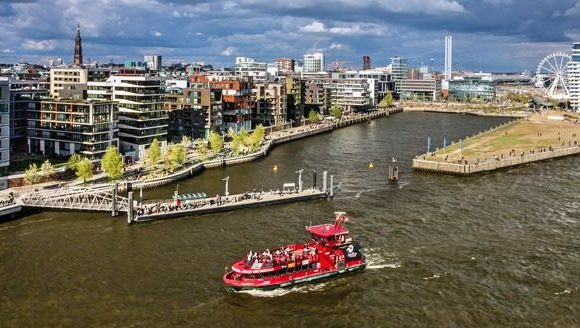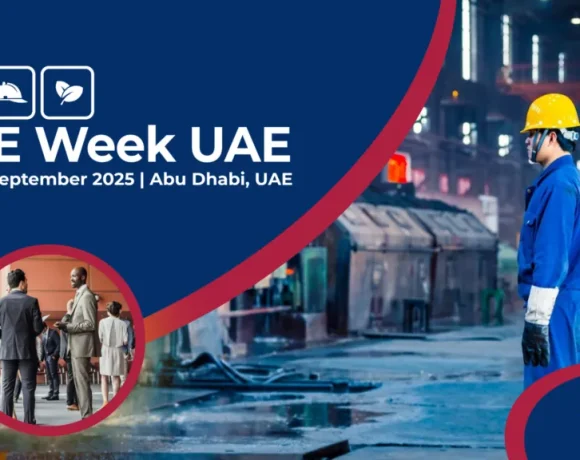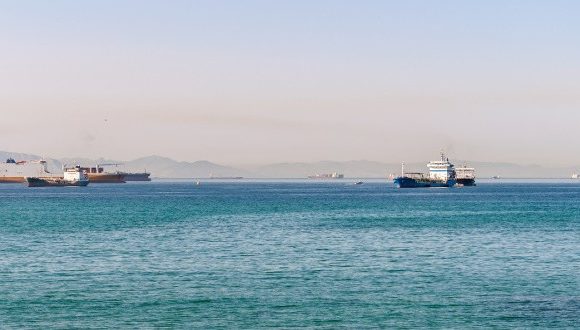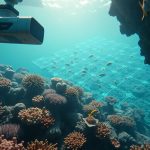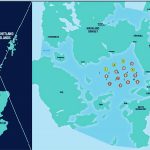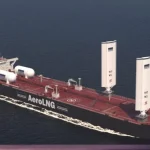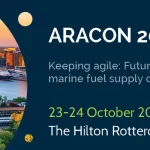From Coral Reefs to Code: Training AI to Recognise Marine Species and Ecosystems
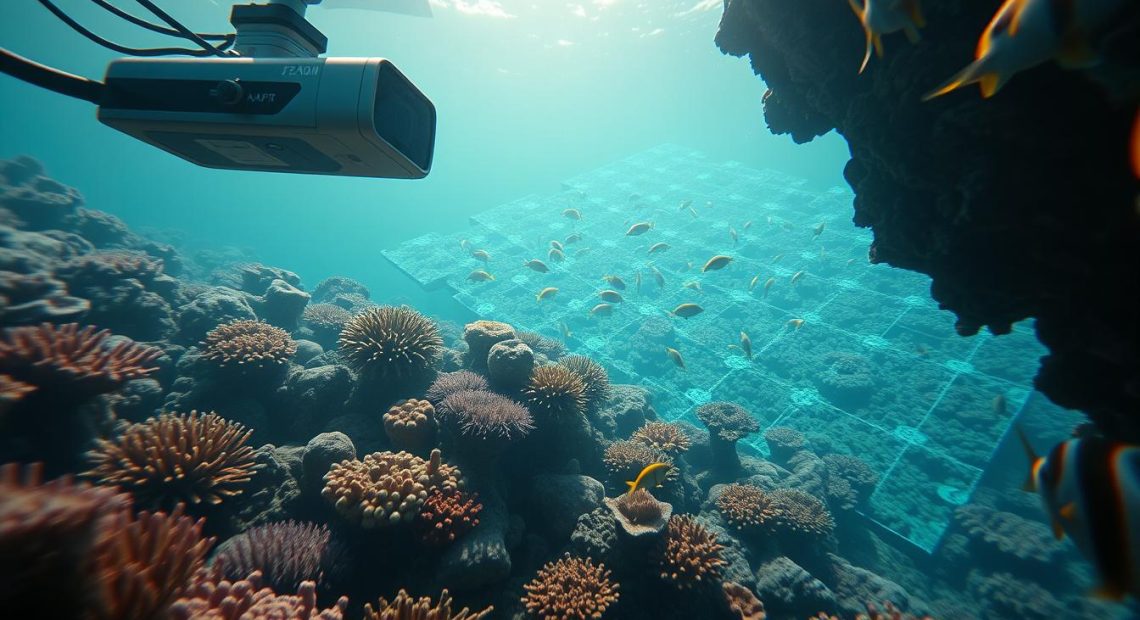
The ocean is full of secrets that scientists have been trying to uncover for centuries. More than 65% of marine species remain unknown to science. This makes it hard to understand the variety of life in the sea.
Old ways of finding out what lives in the ocean are too slow and hard. They can’t keep up with the vast number of species out there.
Artificial intelligence is changing how we study the ocean. New algorithms can look at thousands of underwater pictures in just a few minutes. They find patterns and species that humans would take months to spot.
Companies like NVIDIA provide the computational power needed for these advances. This is making a big difference in how we learn about the sea.
This change is a big deal for marine biology. We’re seeing systems that can find species faster and more accurately than ever before. The mix of new tech and ocean science is opening up new ways to protect and study the sea.
Key Takeaways
- Over 65% of marine species remain undiscovered by traditional scientific methods
- AI technology processes underwater imagery thousands of times faster than manual analysis
- Major technology companies provide essential computational infrastructure for marine research
- Species recognition algorithms demonstrate superior accuracy compared to conventional identification techniques
- The convergence of artificial intelligence and marine biology creates unprecedented conservation opportunities
The Importance of Coral Reefs for Marine Life
Ocean biodiversity is at its highest in coral reefs. These underwater cities are home to many species. They support jobs and economic activities worth $1.5 trillion annually.
Coral reefs are like cities under the sea. They offer shelter, food, and places to breed for many species. Despite covering only 1% of the ocean, they support 25% of marine life.
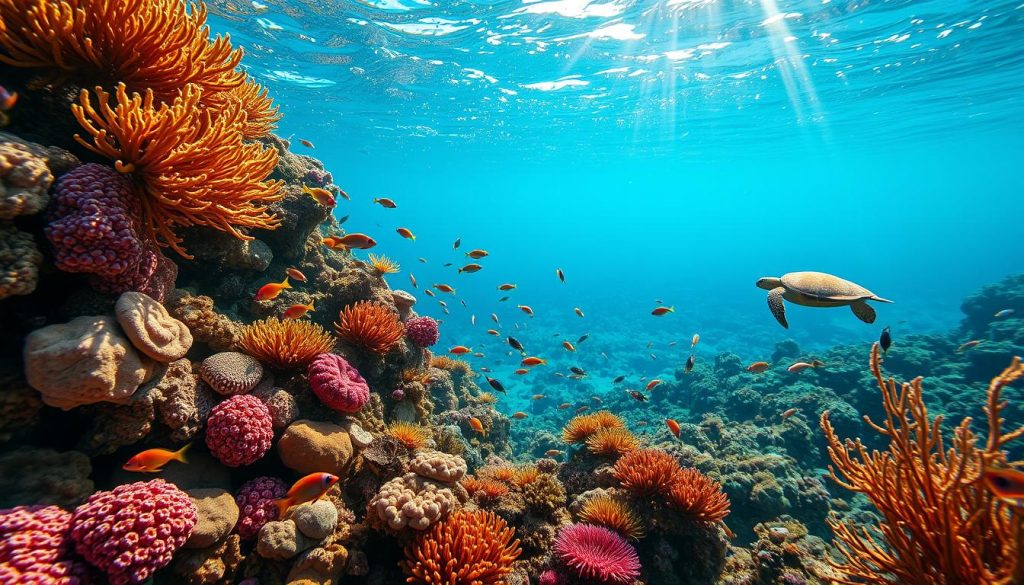
Biodiversity and Ecosystem Services
Coral reefs have many homes for marine life. Young fish hide in coral, and invertebrates find shelter. These places are key for many fish species to grow.
Coral reefs are worth billions of pounds each year. They help fisheries and support tourism. They also protect coasts from storms, reducing damage by up to 97%.
Threats to Coral Reefs
Many threats face coral reefs. Rising sea temperatures cause coral bleaching. Ocean acidification weakens coral, making reefs harder to build.
Human actions harm reefs too. Coastal development and pollution kill habitats. Overfishing also disrupts the balance of reef life.
Coral reef conservation is vital. We need to protect reefs from these threats. But, exploring reefs is hard due to deep water conditions.
The Role of Coral Reefs in Climate Regulation
Coral reefs help control the climate. They absorb carbon dioxide from the air. This helps fight climate change in the ocean.
Corals build structures that store carbon for centuries. Healthy reefs keep doing this. But, damaged reefs can’t store carbon as well, which could harm the climate.
It’s key to protect coral reefs for their climate role. Advanced monitoring technologies help us understand reef health better than before.
Understanding the Challenges in Coral Reef Conservation
Coral reefs face many threats, including human activities and environmental changes. These ecosystems are under pressure, and old ways of protecting them are not enough. NOAA says over 80% of our oceans are unexplored, making it hard to protect reefs well.
We need new ways to tackle these challenges. Each problem adds to the others, causing big issues for reefs. Today’s conservation efforts must deal with many problems at once to make a difference.
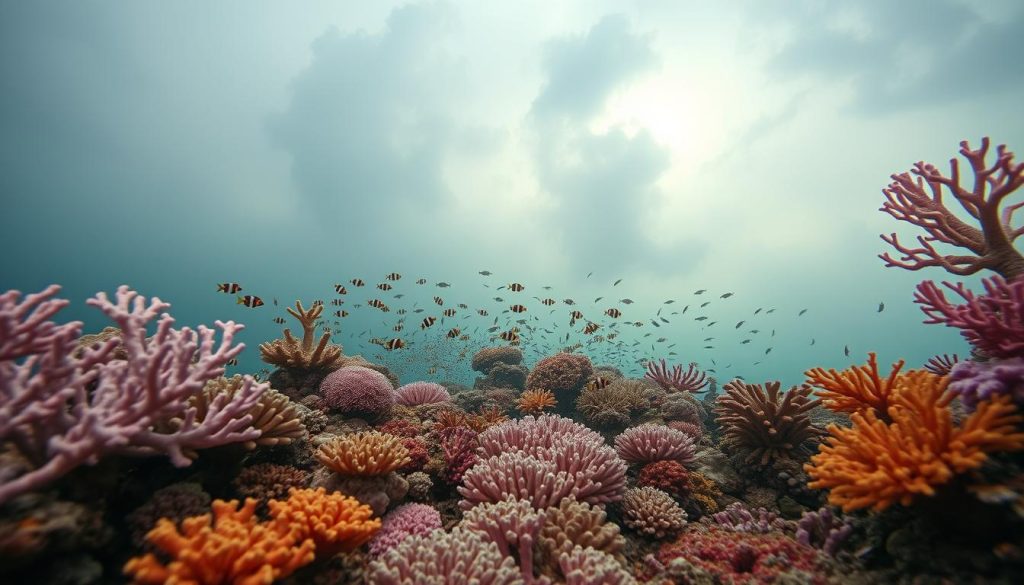
Overfishing and Its Impact
Overfishing messes up the balance in reef communities. It takes away key species that keep the ecosystem healthy. Without these fish, algae can grow too much and harm corals.
Removing predator fish also messes up the food chain. This affects how nutrients move and keeps reefs clean. It’s important to fish sustainably to keep reefs stable.
- Loss of herbivorous fish leads to algae overgrowth
- Predator removal disrupts natural food chains
- Reduced biodiversity weakens ecosystem resilience
- Traditional fishing methods require modernisation
Pollution and Coral Health
Marine pollution is a big threat to coral health. The world makes a lot of plastic, and most of it ends up in the ocean. This pollution harms corals in many ways.
Chemicals from farms also hurt reefs. These chemicals make algae grow too much, competing with corals. Plastic debris can also damage coral tissues, making them sick.
It’s key to monitor water quality to find pollution sources. Coastal development and industries add more pollutants, stressing corals even more.
Climate Change Effects
Climate change is the biggest threat to coral reefs. Rising sea temperatures cause corals to lose their algae. This makes corals lose their colour and main food source.
Ocean acidification is another big problem. As the ocean absorbs more carbon dioxide, it becomes more acidic. This makes it hard for corals to build their skeletons.
Weather patterns are changing, bringing more storms and altering currents. These changes affect water temperature, nutrients, and sediment around reefs. We need to protect reefs from these fast-changing environmental issues.
The effects of warming, acidification, and extreme weather are putting a lot of stress on coral systems worldwide.
AI Technology in Marine Research
Artificial intelligence is changing marine research a lot. It uses advanced methods to quickly process underwater data. This means that what used to take months can now be done in just days.
This new technology lets researchers cover huge ocean areas more accurately and quickly. It’s a big improvement over old methods.
The changes go beyond just faster data processing. AI systems can look at thousands of underwater images at once. They spot patterns and changes that humans might miss. This is really helpful for studying places like the Great Barrier Reef, where there’s a lot to watch.
Revolutionary Research Methodologies
Machine learning has changed how scientists study the sea. It uses special software to quickly identify many marine species. This makes the work more consistent and less prone to human error.
Now, underwater robots with AI cameras do surveys on coral reefs. They work all the time, even when it’s not safe for people. This means we get more data and a better understanding of the reefs.
Enhanced Data Processing Capabilities
Modern marine research creates a lot of data. AI algorithms are great at handling this big data. They find trends and patterns that show how healthy the sea is. This helps scientists track changes in marine life over time.
Before, analyzing data took a lot of time and special skills. Now, machines can do it automatically. They make detailed reports on environmental changes and how species are doing. This lets scientists focus on what they do best.
Continuous Ecosystem Surveillance
One of the biggest advances is real-time monitoring. AI sensors watch coral reefs all the time. They quickly spot any big changes or threats. This is key for keeping ecosystems safe.
The Great Barrier Reef is a big beneficiary of this technology. It tracks water conditions and where species are moving. If the reef is in danger, it can act fast. This is a big step up from just reacting to problems.
By combining this data with satellite images and ocean info, scientists can make detailed models. These models help predict changes and plan for conservation. This mix of real-time data and predictions gives researchers powerful tools to protect the sea.
Training AI to Recognise Marine Species
Teaching AI to spot marine life needs smart methods. These mix new tech with marine biology knowledge. It’s about making strong datasets and algorithms to tell apart thousands of species in marine ecosystems.
This tech helps save marine life and makes sustainable tourism better. It does this by improving how we watch species and teach visitors.
Data Collection Techniques
AI training starts with gathering lots of data. Underwater cameras take clear photos and videos in different depths and lights. They face challenges like murky water and moving sea creatures.
Listening to the sea is also key. Researchers use sound to find out what’s in the water. Satellite images help AI see how species live together in the sea.
Putting all these data together makes a big training set. Important ways to collect data include:
- Autonomous underwater vehicles with cameras
- Hydrophone arrays for sound
- Remote sensing for maps
- Help from diving fans
Machine Learning Algorithms for Identification
Deep neural networks are the core of marine species recognition. They look at lots of pictures and sounds to find what’s special about each species. The AI learns by seeing millions of examples.
Special algorithms tackle underwater challenges. They handle murky water and changing lights. The AI gets better with more training.
These algorithms use cool techniques like:
- Convolutional neural networks for images
- Recurrent neural networks for sounds
- Transfer learning to adapt models
- Ensemble methods for better results
Case Studies of AI Applications
Teams from Wageningen University and EPFL have made AI detectors work well. They used deep neural networks and learned from experts. This shows AI’s real-world uses.
Studies show AI can identify species with 95% accuracy after huge training. This helps science and tourism by keeping track of species.
AI helps save the sea by quickly sorting through data. It finds patterns and changes in species numbers. This tech is a big help for both science and tourism.
Marine Ecosystems and Their Interdependence
Marine ecosystems are complex and interconnected. Coral reefs are key structures that support ocean biodiversity. Each species plays a role in keeping the marine environment healthy. AI technology helps scientists map these relationships with great detail.
The Allen’s Coral Atlas shows how AI changes our view of marine ecosystems. It uses satellite images and field data to uncover hidden patterns. This technology gives us insights into how species interact and depend on each other.
The Role of Coral Reefs in Coastal Protection
Coral reefs act as natural barriers against waves and storms. They can absorb up to 97% of wave energy. This reef protection saves coastal communities billions of pounds each year.
The effectiveness of reefs in protecting coastlines depends on their health. Healthy reefs with diverse coral formations offer better protection. AI helps scientists predict which reef structures are best for different weather conditions.
“Coral reefs are nature’s most effective coastal defence systems, providing protection that no human-engineered structure can match in terms of both effectiveness and environmental benefit.”
Relationships with Other Marine Species
Ocean biodiversity thrives in complex relationships around coral reefs. Cleaner fish remove parasites from larger species. Herbivorous fish control algae growth that could harm corals. These partnerships keep the ecosystem balanced.
Deep learning algorithms uncover new species interactions by analysing genetic and metabolic data. This technology shows how disruptions to one species can affect the whole ecosystem. Such insights are key for conservation strategies.
Predator-prey dynamics are vital for reef health. Sharks and other apex predators control fish populations that might overgraze coral polyps. AI monitoring systems track these relationships in real-time, alerting researchers to any imbalances.
Ecosystem Resilience and Adaptation
Marine ecosystems can adapt to changes when their structures are intact. Reef protection efforts aim to maintain this resilience. Machine learning identifies which reefs are most adaptable.
Ecosystem resilience relies on species diversity and genetic variation. AI systems analyse many variables to predict how reefs might respond to climate change. This information guides restoration efforts to the most promising locations.
Adaptation mechanisms include coral bleaching recovery, species migration patterns, and evolutionary responses to temperature changes. Understanding these processes helps in planning conservation efforts that work with nature.
Public Awareness and Engagement
The use of artificial intelligence in marine science is changing how we work together to protect coral reef conservation. It’s making it easier for people to join in marine research. Now, anyone can help with conservation and learn more about the sea.
AI is opening new ways for people to help the environment. People can now help collect data and identify species, something only experts used to do. This teamwork makes conservation better by getting more data and covering more areas.
Educational Initiatives on Coral Reefs
AI is being used in schools to teach about the sea. Now, people can use apps to learn about coral species while at the beach. These tools give real-time info on coral health and more.
Sustainable tourism is using these tools to offer unique experiences. Diving spots and marine parks have AI guides for visitors. This way, tourists help with research while enjoying their time, helping both education and science.
“Technology has the power to transform every citizen into a marine conservationist, providing them with the tools and knowledge needed to make a real difference.”
The Role of Citizen Science
Citizen science projects are growing thanks to AI. ClearBot asks people to send photos of marine plastic to help train AI. This helps learn about pollution faster and gets more people involved.
People in these projects learn a lot about sea problems. They learn to spot different types of pollution and how it affects the ocean. This hands-on learning leads to lasting changes in how people think about the sea.
Promoting Conservation Efforts
Getting communities involved is key to saving coral reefs. The Gringgo Indonesia Foundation shows how effective this can be. They use AI to help sort waste, leading to more recycling.
These tech solutions help local communities protect the sea. Workers learn new skills and help keep the ocean clean. The benefits of accurate waste sorting encourage more people to join in.
Good engagement strategies mix new tech with real benefits. When people see how their efforts improve their lives, they’re more likely to keep helping. This leads to lasting protection of our oceans.
Collaboration Between Technology and Conservation
Technology giants and conservation groups are teaming up to protect our oceans. They use advanced artificial intelligence and deep environmental knowledge. This mix creates powerful tools for watching over marine life.
Modern conservation needs big computers and special knowledge. Technology companies offer AI, cloud computing, and machine learning skills. Conservation groups bring field experience, biological knowledge, and research networks.
Partnerships Between Tech Companies and NGOs
Microsoft’s AI for Earth programme is a great example of working together. It gives grants and computing power to groups working on coral bleaching detection and climate change impact. This helps researchers quickly analyse huge amounts of data.
Google’s work with marine research shows how cloud computing helps conservation. Their platforms let researchers quickly check underwater images for coral bleaching. NVIDIA helps train AI to spot small changes in coral health.
The Ocean Cleanup uses machine learning to find and track plastic pollution. Their AI looks at thousands of examples from the air to predict where debris will go.
Funding and Resource Allocation
Marine research often lacks money, limiting long-term projects. Technology partnerships offer millions of pounds worth of computing power. This cuts costs for conservation groups.
Companies are now investing in environmental tech projects. They give money for marine conservation partnerships. This helps fund projects like automated boats and sensors for coral reefs.
Success Stories in Conservation
Recent partnerships have made big strides in coral bleaching prediction. AI spots early signs of stress in coral reefs. This lets teams act fast to stop bleaching.
Automated systems watch over marine ecosystems all the time. They send alerts for changes, pollution, or unusual species. This quick action has stopped many ecological disasters.
Using satellite images with AI has changed reef monitoring. Groups can now check coral health over huge areas. They find vulnerable spots that need help.
Future Prospects for Coral Reef Ecosystems
New scientific discoveries are opening doors for coral reef restoration. Advanced artificial intelligence is being used with traditional marine biology. This is creating new ways to protect reef protection worldwide.
These new methods are changing how we save marine ecosystems for the future.
Next-generation conservation uses data from different sources. It combines visual, acoustic, and environmental data. This helps researchers predict changes in ecosystems and where species live.
Innovations in Coral Restoration
New coral restoration methods are coming from biotechnology and AI. Scientists are using AI to find the best places to plant corals. They look at water temperature, currents, and ecosystem health.
These systems check how well the restoration is going. They adjust their plans based on what they learn. Reef protection now has automated systems that watch coral growth and survival.
3D printing is making artificial reefs for corals to grow on. This speeds up the restoration and helps marine ecosystems recover faster.
Potential of Genetic Engineering
Genetic engineering is showing great promise for corals. Scientists are breeding corals that can handle warmer seas and acidifying oceans. AI helps guide this process.
These corals can live better in tough conditions. They keep their natural relationships but are more resilient. This technology creates corals that fit local marine ecosystems needs.
Reef protection now includes genetic diversity mapping. This ensures coral populations stay healthy for the long term.
Long-Term Monitoring and Research Strategies
Systems are being set up to watch ecosystem health for decades. They use satellite images, underwater sensors, and AI to track health. This gives detailed profiles of ecosystems.
These systems can predict threats to marine ecosystems. They warn of bleaching, diseases, or environmental changes that harm corals.
Research aims to understand how ecosystems can bounce back. This knowledge helps shape future conservation policies and restoration plans worldwide.
Policy Making and Coral Reef Protection
Effective coral reef conservation needs strong policies that use AI and traditional ways. Policymakers today face big challenges in protecting oceans while keeping the economy and environment balanced. AI gives the data needed for policies that quickly respond to environmental changes.
AI changes how governments protect marine life. It looks at lots of data to find trends and threats that old methods might miss. This helps policies change faster and conservation efforts get more focused.
International Agreements and Their Impact
Global marine conservation efforts have grown thanks to AI. The Convention on Biological Diversity and others now use AI data for policy decisions. This makes tracking progress towards ocean biodiversity targets clearer.
AI helps standardise monitoring across regions. Countries can compare data using the same metrics. This makes global conservation efforts more effective.
- Enhanced monitoring capabilities across international waters
- Standardised data collection protocols for global comparison
- Real-time threat assessment for rapid response coordination
- Evidence-based target setting for conservation goals
National Policies in the UK
The UK’s marine protected areas show how AI helps national coral reef conservation policies. British overseas territories with coral reefs use advanced monitoring. This helps make better management decisions.
UK policymakers use AI to check if conservation works. This data helps them keep improving policies. Technology makes conservation efforts more effective.
Local Community Involvement
AI tools make community involvement in policy better. They give real-time info about local marine environments. This helps communities make informed decisions about conservation.
AI makes complex data easy for communities to understand. This way, local knowledge and scientific evidence work together. Communities can help protect their marine resources.
The future of marine conservation is about combining technology with community efforts. This makes policies that are both scientifically sound and relevant to locals.
Together, international cooperation, national policies, and local involvement protect oceans. AI connects all these efforts, making conservation effective and sustainable.
The Role of Individuals in Coral Conservation
Every person can help protect coral reefs by making smart choices. AI has changed how we can help marine conservation. Now, digital tools let ordinary people join scientific research and learn about the ecosystems they protect.
AI has opened new ways for people to get involved in conservation. Mobile apps can identify marine species instantly. These apps turn casual observers into important data collectors for research around the world.
“Technology has made marine conservation accessible to everyone. Now, every individual can help protect our ocean’s precious ecosystems.”
Responsible Travel Practices
Sustainable tourism is a key way to support coral reefs. AI apps guide tourists to make eco-friendly choices. These tools give real-time info on ecosystem health and species behaviour.
AI apps suggest reef-safe sunscreens. They analyse chemicals and offer tips to protect marine life. Smart booking platforms also highlight eco-friendly tour operators.
Snorkelling and diving get a boost from AI species identification tools. Visitors get instant info on marine life. This tech turns fun activities into chances to learn about climate change impact on oceans.
Corporate Environmental Responsibility
Businesses can use AI to help coral reefs. Hotels and resorts use AI to monitor water quality. These systems track environmental impact on marine ecosystems.
Tour operators use AI to plan visits. This prevents overcrowding and supports reef health. AI scheduling helps reefs recover and keeps operations profitable.
Restaurants and hotels use AI to find sustainable seafood. AI identifies suppliers that protect reefs. This tech helps businesses choose seafood that supports marine conservation.
Daily Conservation Actions
Our daily choices affect coral reefs and climate change impact. AI tools help us understand our environmental footprint. They offer tips to reduce our impact.
Smartphone apps make marine research accessible. Users contribute photos and data to global databases. This approach educates people and supports coral health research.
Our choices on plastic, energy, and transport affect the ocean. AI apps help us find eco-friendly products. They scan barcodes and rate products for sustainability.
- Download marine species identification apps for educational reef visits
- Choose reef-safe sunscreens recommended by AI analysis tools
- Participate in citizen science projects through mobile applications
- Support businesses using AI for sustainable tourism practices
- Use carbon footprint calculators to understand climate impact
AI and individual action together offer great chances for coral reef protection. Technology empowers us to make informed choices for marine ecosystems. Together, we can make a big difference in coral reef conservation.
Conclusion: Bridging Technology and Nature
The mix of artificial intelligence and marine conservation is a big step forward. It changes how we protect our oceans. Now, we can monitor, understand, and save marine life better than ever before.
The Path Forward for Coral Reefs
Future AI will watch over our oceans with better accuracy and reach. It will use advanced sensors and learning machines. This will help us save coral reefs from big dangers.
Integrating AI Into Conservation Practices
To use AI well, we need strong systems and training. We must share data globally and make sure tech helps conservation everywhere. This way, we can quickly respond to threats and protect our reefs.
A Collective Responsibility for Future Generations
AI is a great tool, but saving our oceans needs everyone’s help. Governments, companies, communities, and people must join forces. Together, we can use technology and our efforts to keep coral reefs and oceans healthy for the future.

